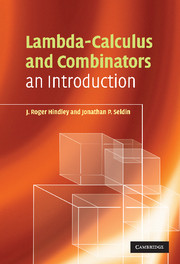Book contents
- Frontmatter
- Contents
- Preface
- 1 The λ-calculus
- 2 Combinatory logic
- 3 The power of λ and combinators
- 4 Representing the computable functions
- 5 The undecidability theorem
- 6 The formal theories λβ and CLw
- 7 Extensionality in λ-calculus
- 8 Extensionality in combinatory logic
- 9 Correspondence between λ and CL
- 10 Simple typing, Church-style
- 11 Simple typing, Curry-style in CL
- 12 Simple typing, Curry-style in λ
- 13 Generalizations of typing
- 14 Models of CL
- 15 Models of λ-calculus
- 16 Scott's D∞ and other models
- Appendix A1 Bound variables and α-conversion
- Appendix A2 Confluence proofs
- Appendix A3 Strong normalization proofs
- Appendix A4 Care of your pet combinator
- Appendix A5 Answers to starred exercises
- References
- List of symbols
- Index
Appendix A1 - Bound variables and α-conversion
Published online by Cambridge University Press: 05 June 2012
- Frontmatter
- Contents
- Preface
- 1 The λ-calculus
- 2 Combinatory logic
- 3 The power of λ and combinators
- 4 Representing the computable functions
- 5 The undecidability theorem
- 6 The formal theories λβ and CLw
- 7 Extensionality in λ-calculus
- 8 Extensionality in combinatory logic
- 9 Correspondence between λ and CL
- 10 Simple typing, Church-style
- 11 Simple typing, Curry-style in CL
- 12 Simple typing, Curry-style in λ
- 13 Generalizations of typing
- 14 Models of CL
- 15 Models of λ-calculus
- 16 Scott's D∞ and other models
- Appendix A1 Bound variables and α-conversion
- Appendix A2 Confluence proofs
- Appendix A3 Strong normalization proofs
- Appendix A4 Care of your pet combinator
- Appendix A5 Answers to starred exercises
- References
- List of symbols
- Index
Summary
In Chapter 1 the technicalities of bound variables, substitution and α-conversion were merely outlined. This is the best approach at the beginning. Indeed, most accounts of λ omit details of these, and simply assume that clashes between bound and free variables can always be avoided without problems; see, for example, the ‘variable convention’ in [Bar84, Section 2.1.13]. The purpose of this appendix is to show how that assumption can be justified.
Before starting, it is worth mentioning two points. First, there is a notation for λ-calculus that avoids bound variables completely. It was invented by N. G. de Bruijn, see [Bru72], and in it each bound variable-occurrence is replaced by a number showing its ‘distance’ from its binding λ, in a certain sense. De Bruijn's notation has been found useful when coding λ-terms for machine manipulation; examples are in [Alt93, Hue94, KR95]. But, as remarked in [Pol93, pp. 314–315], it does not lead to a particularly simple definition of substitution, and most human workers still find the classical notation easier to read.
For such workers, the details of α-conversion would not be avoided by de Bruijn's notation, but would simply be moved from the stage of manipulating terms to that of translating between the two notations.
The second point to note is shown by the following two examples: if we simply deleted ≡α from the rules of λ-calculus, we would lose the confluence of both ⊳βη and ⊳β.
- Type
- Chapter
- Information
- Lambda-Calculus and CombinatorsAn Introduction, pp. 276 - 281Publisher: Cambridge University PressPrint publication year: 2008

